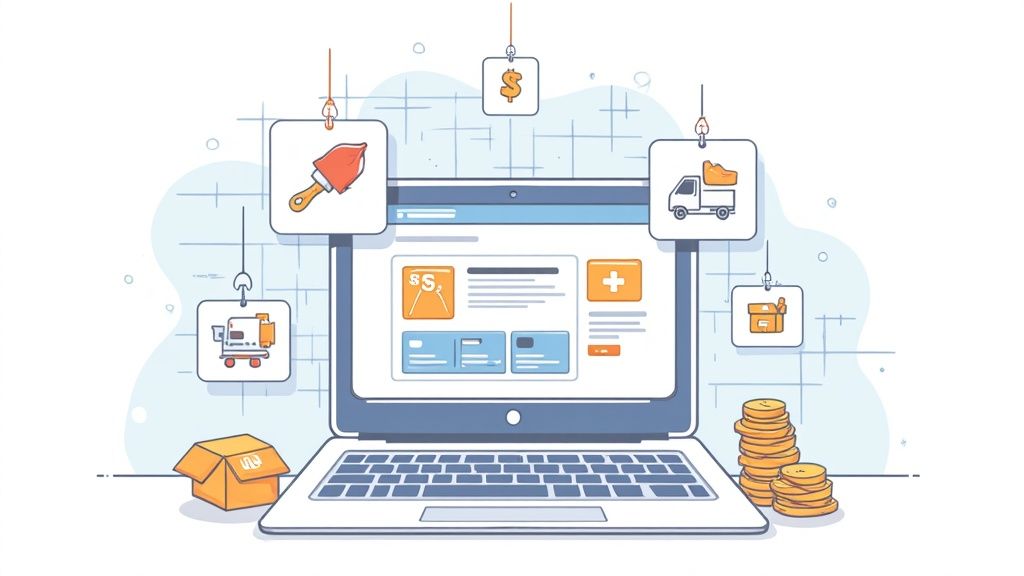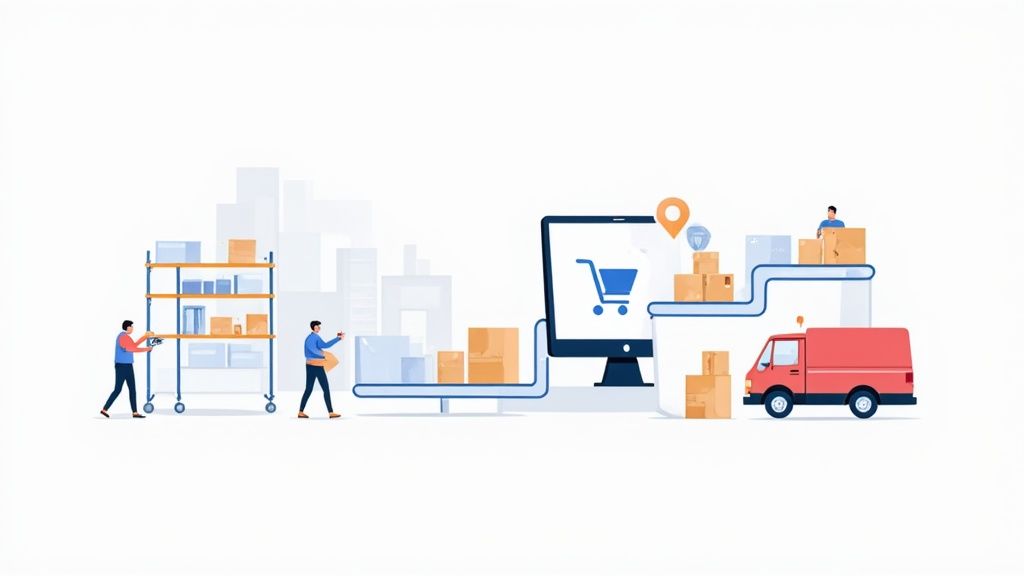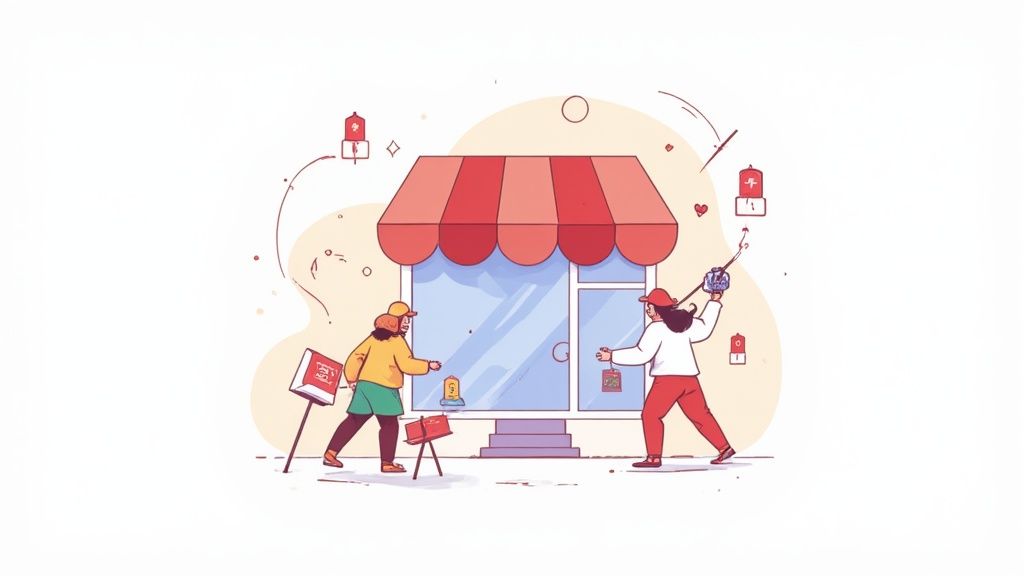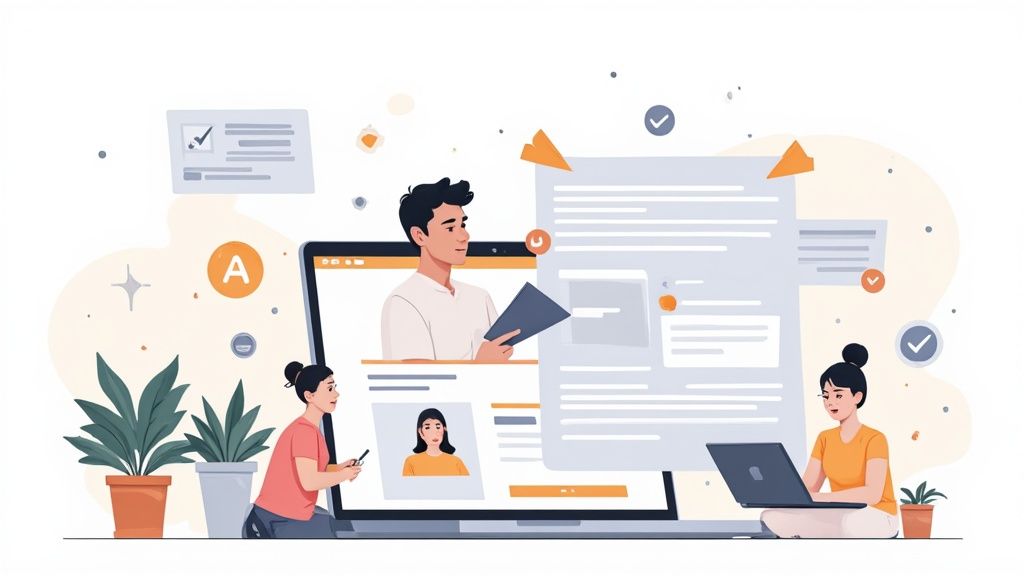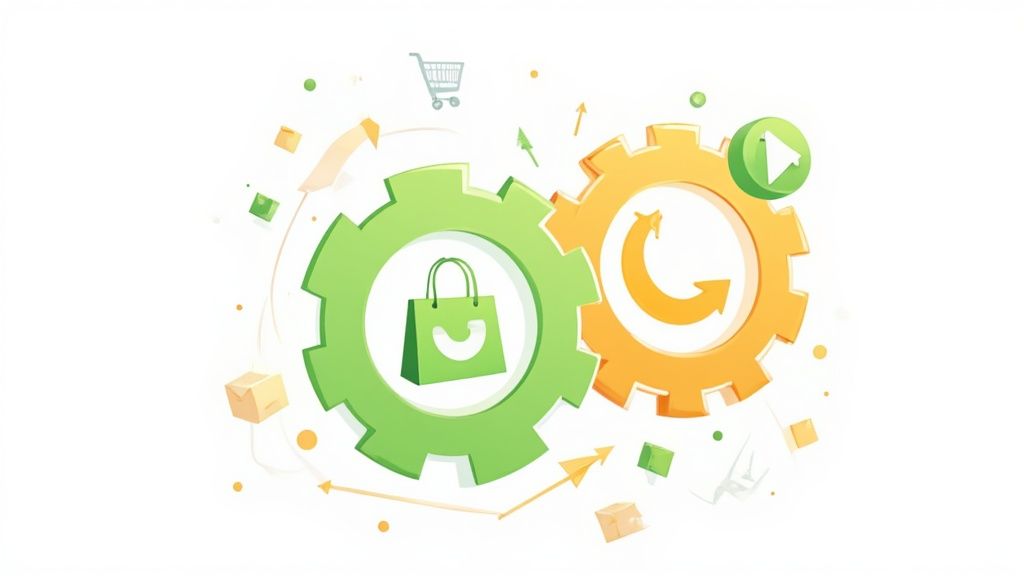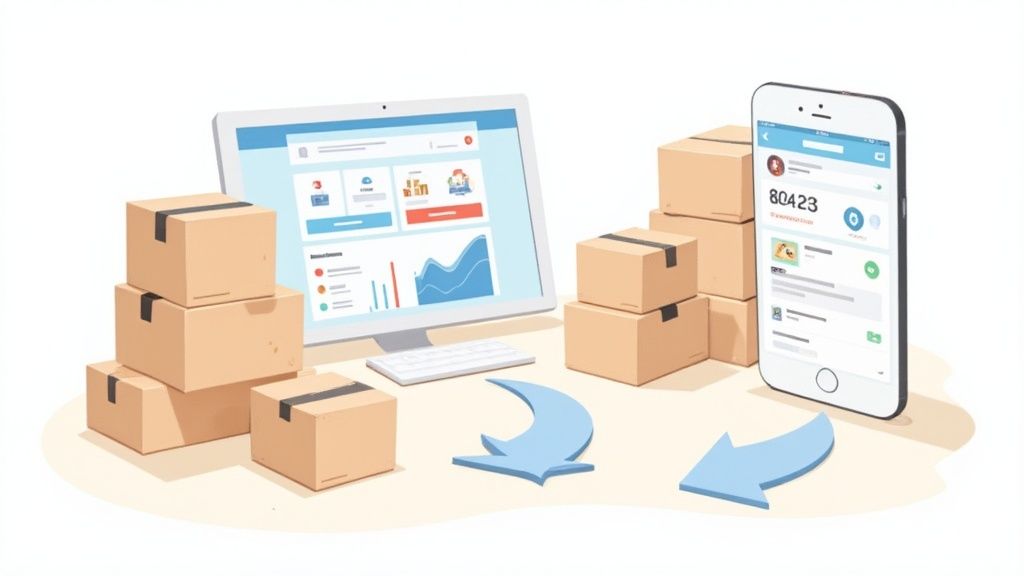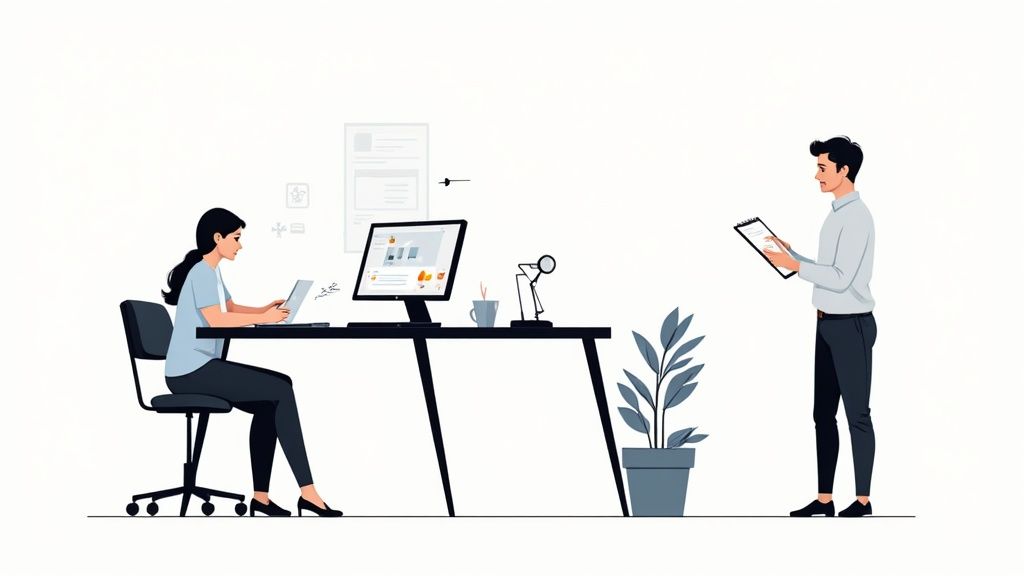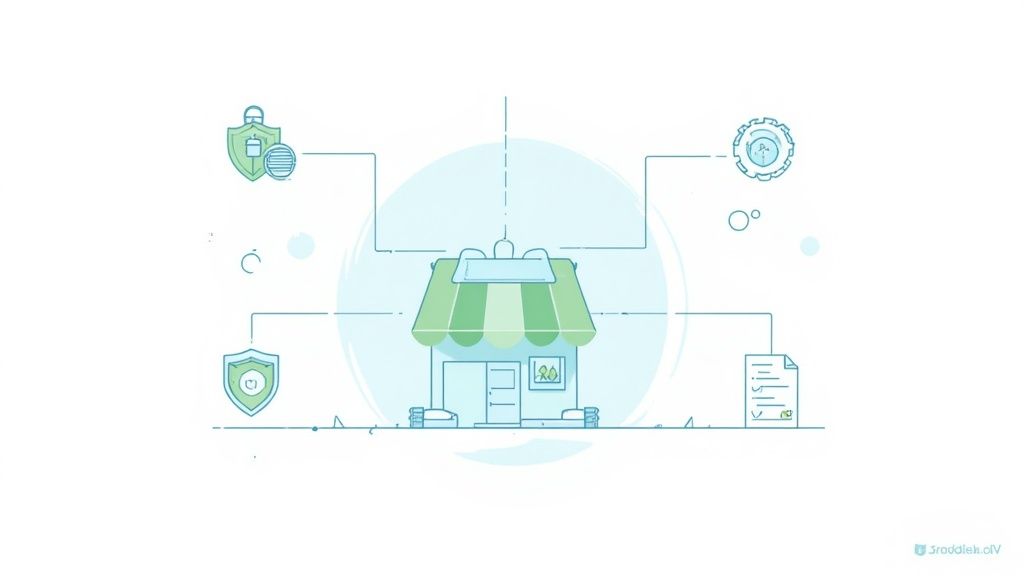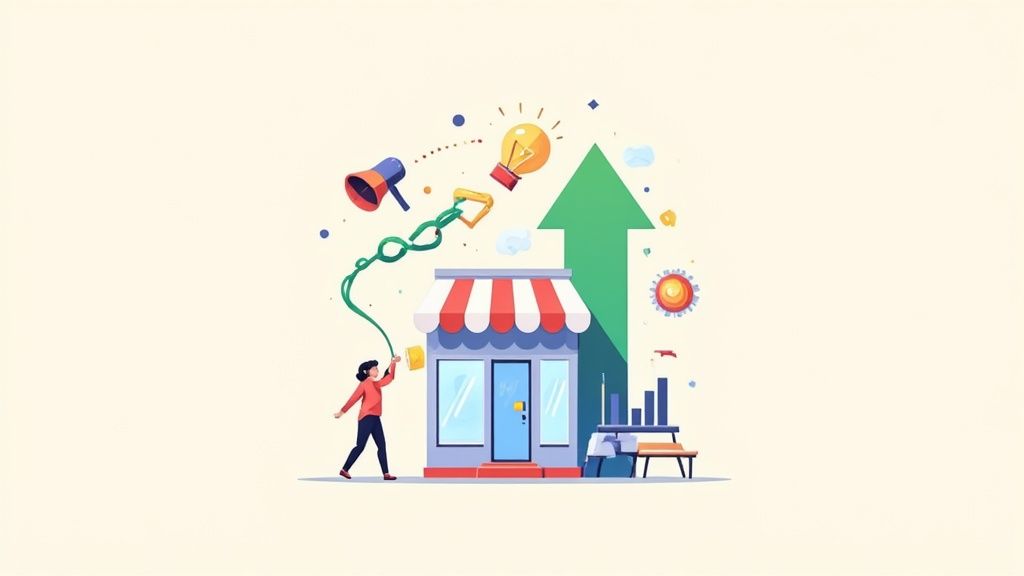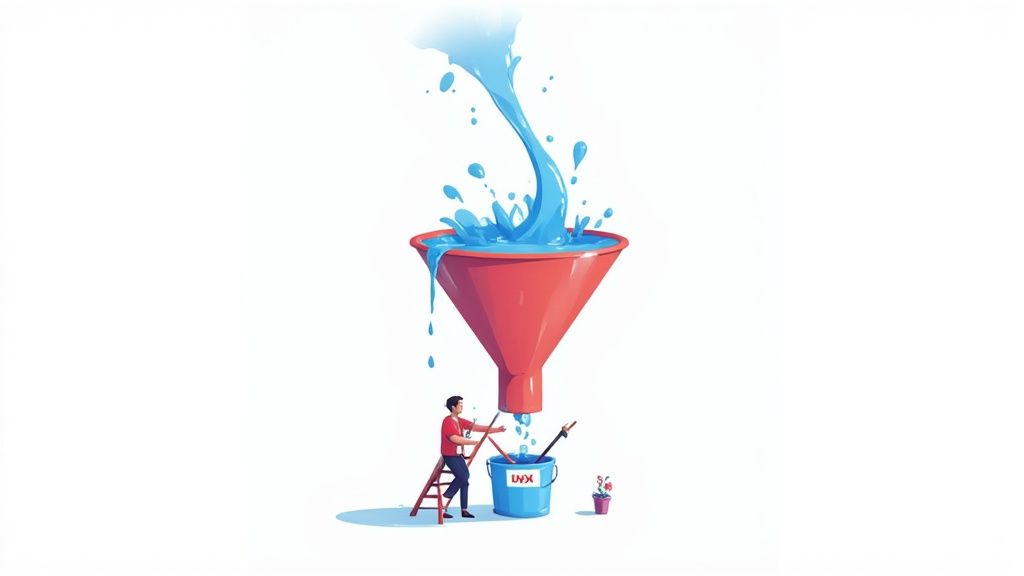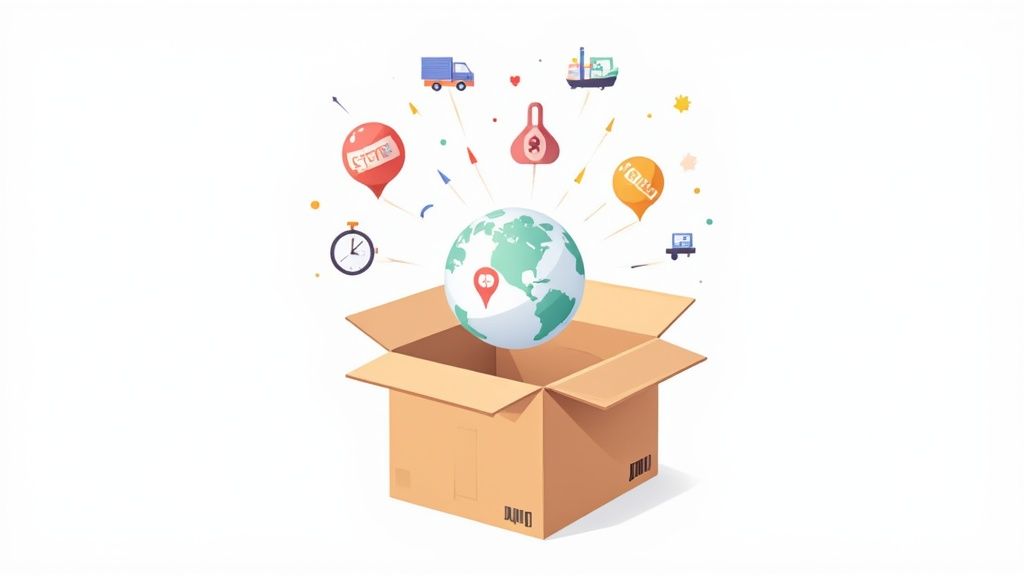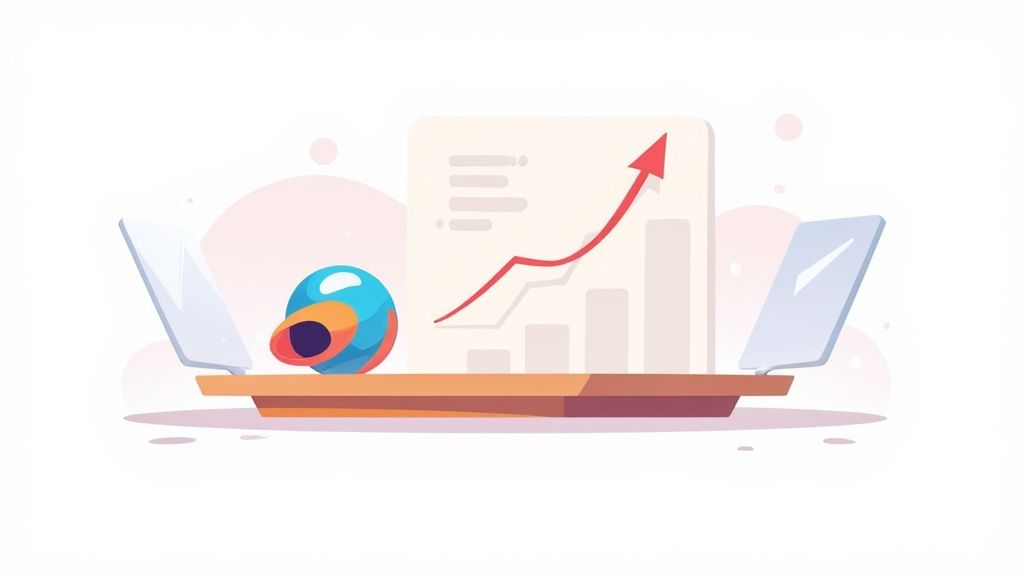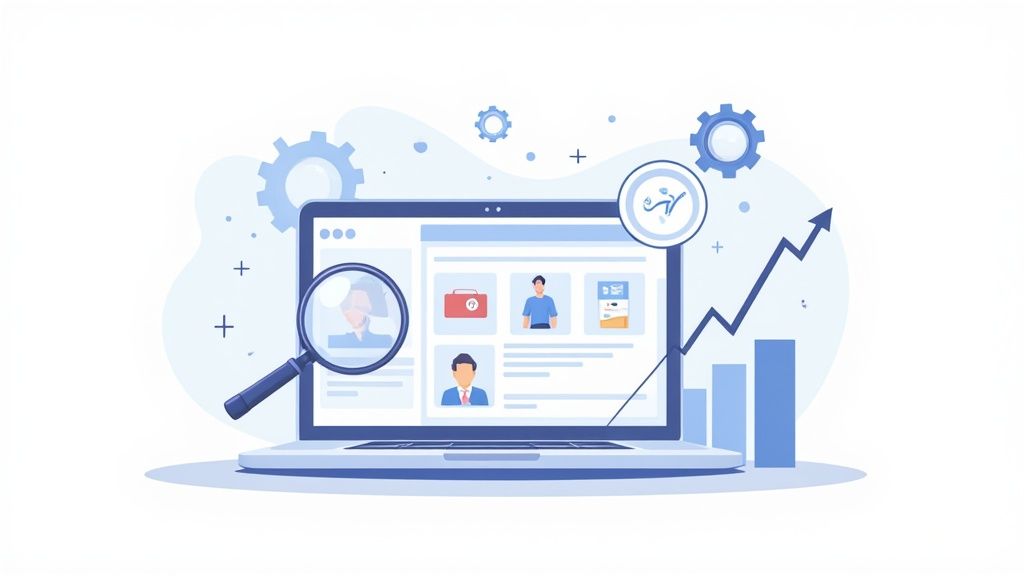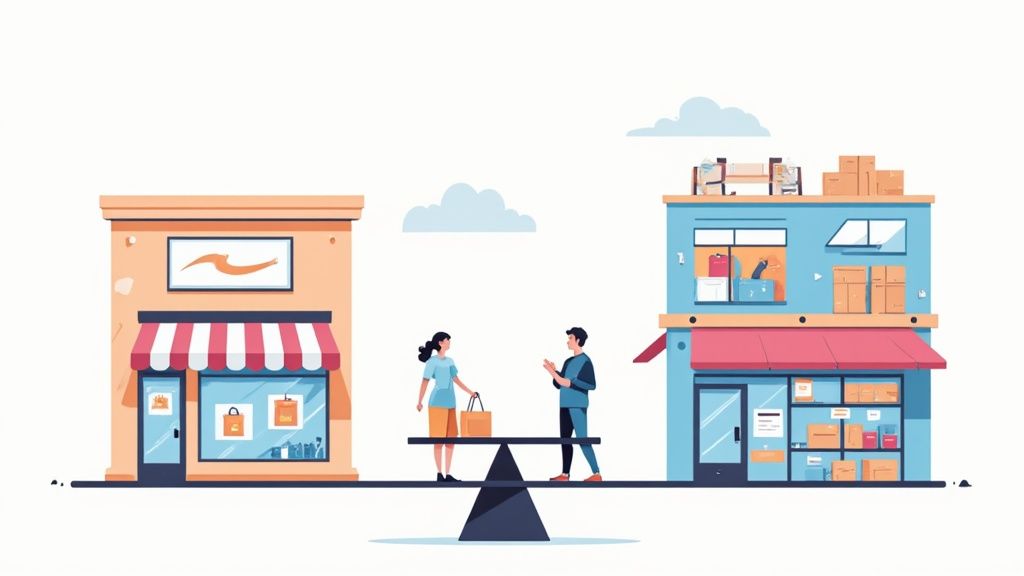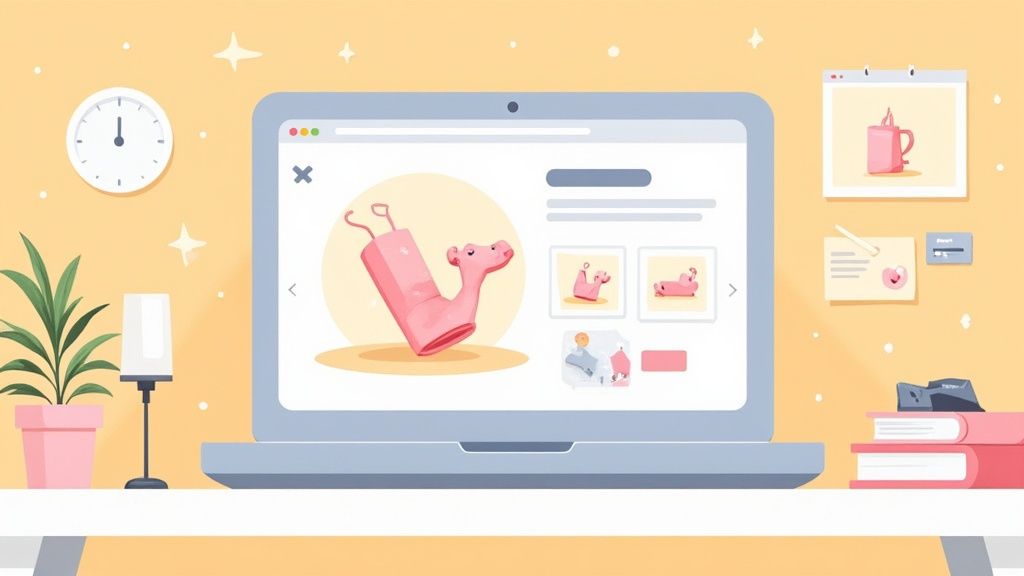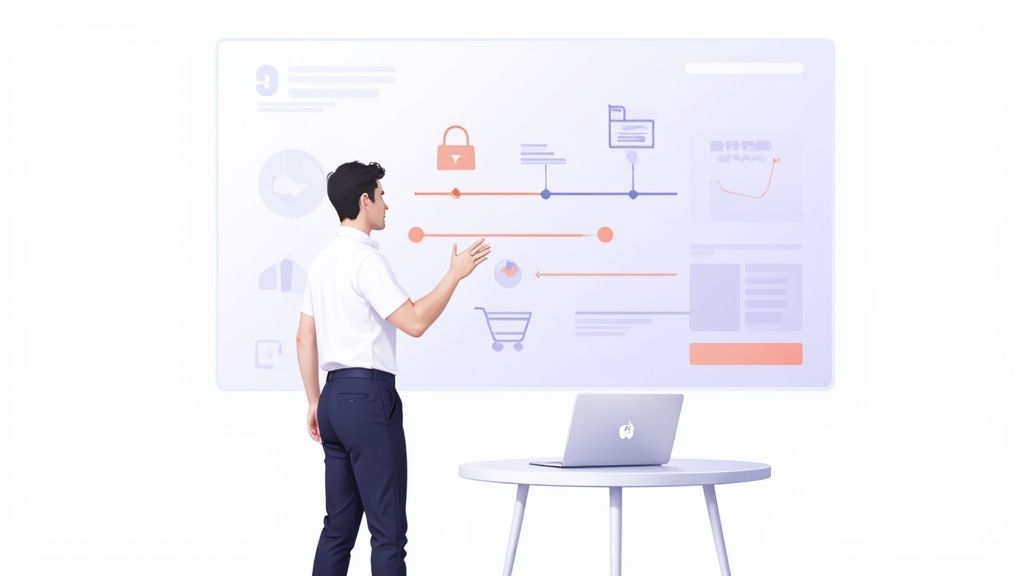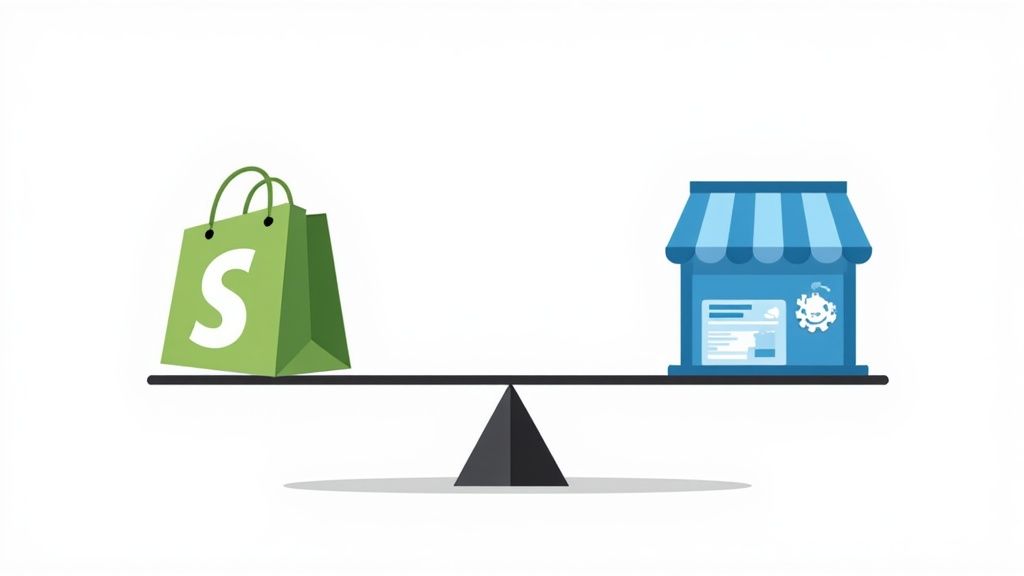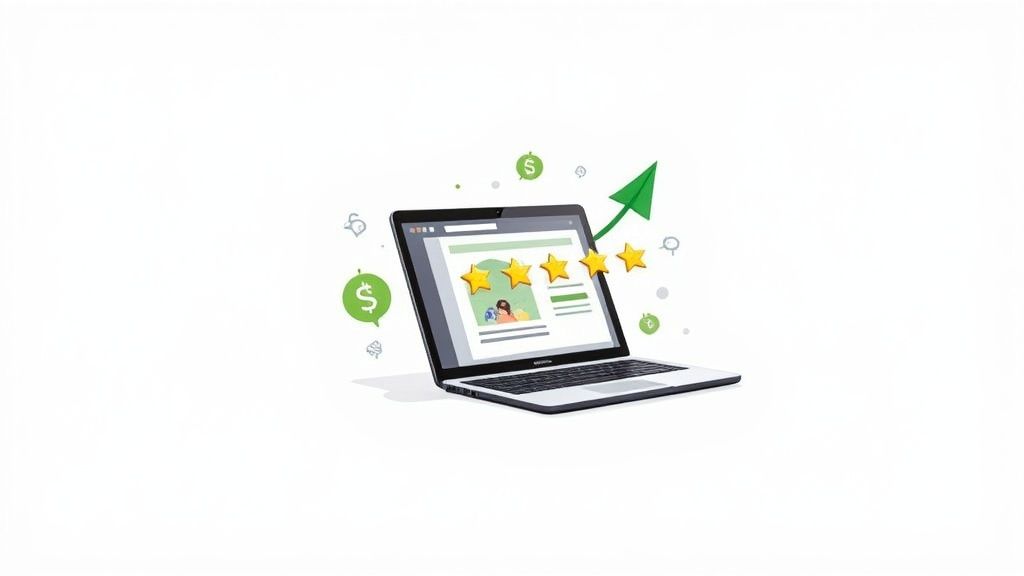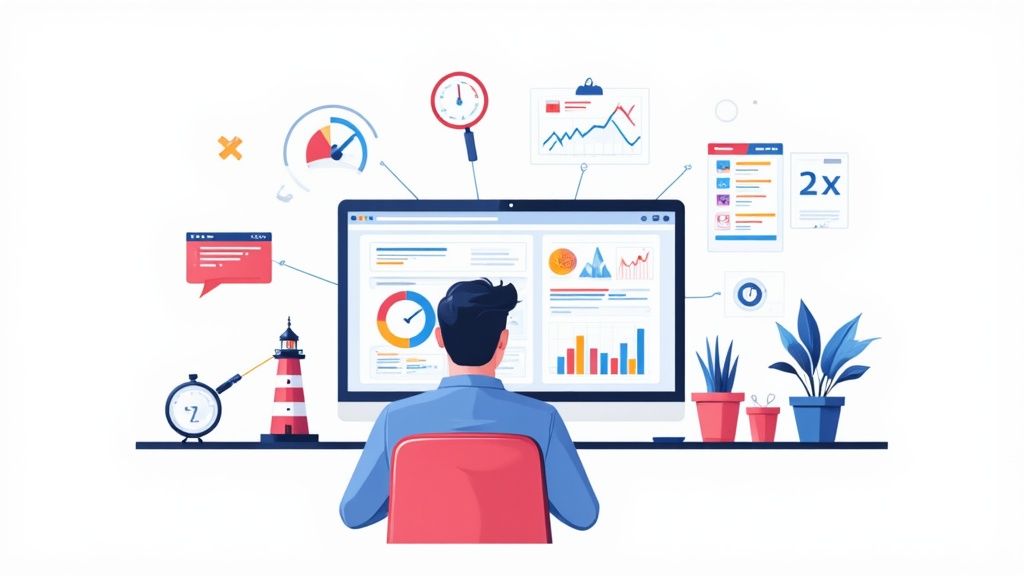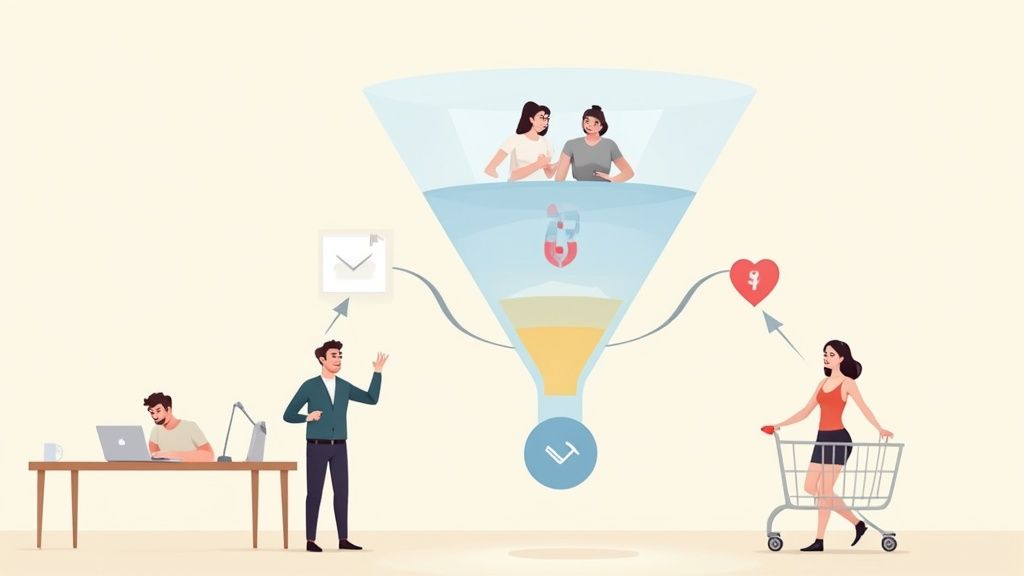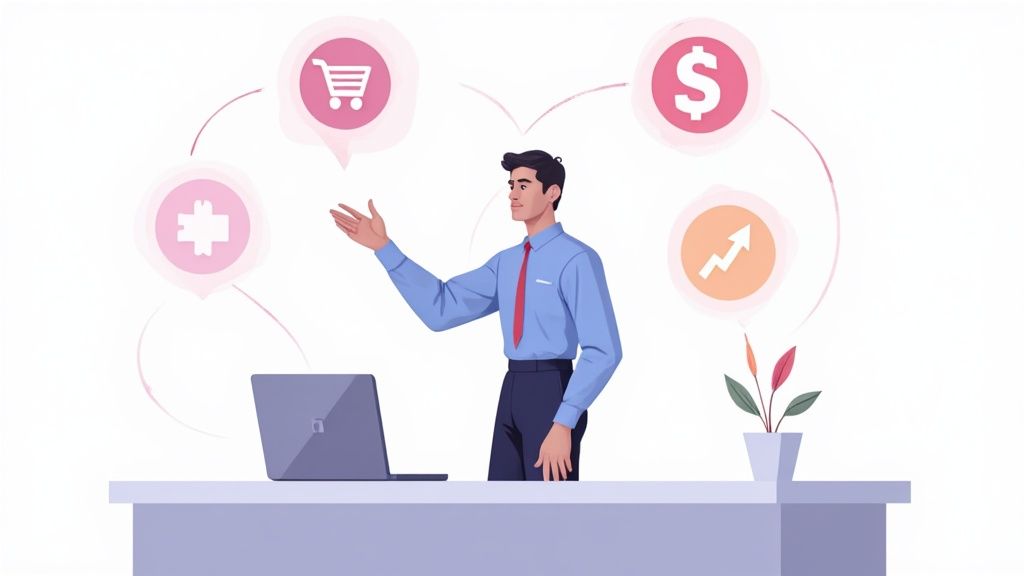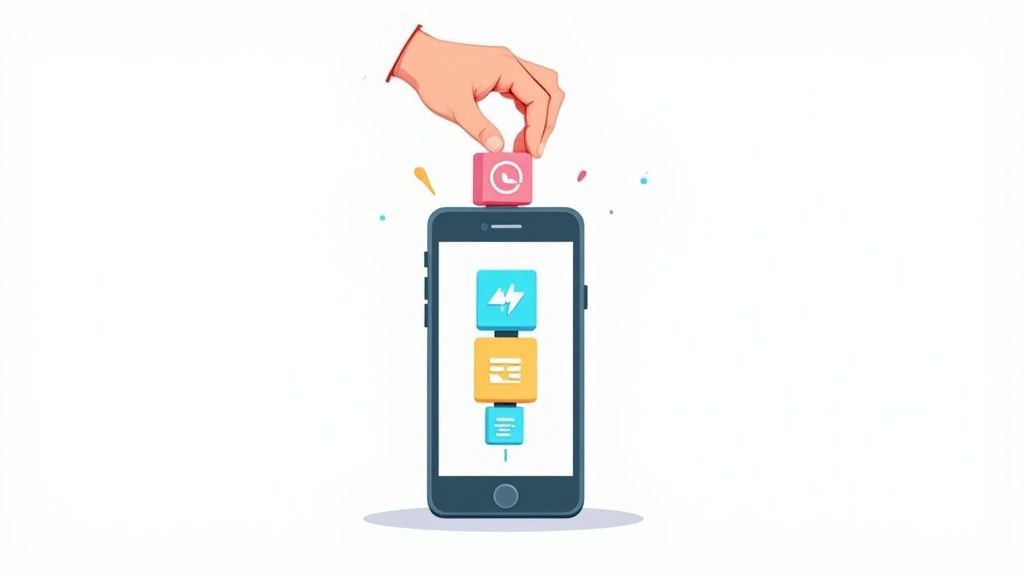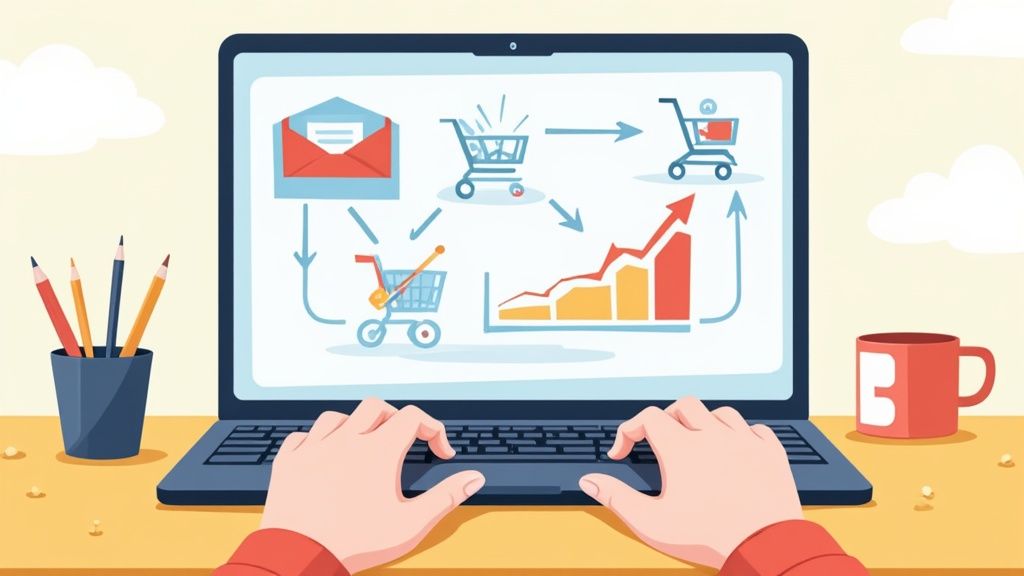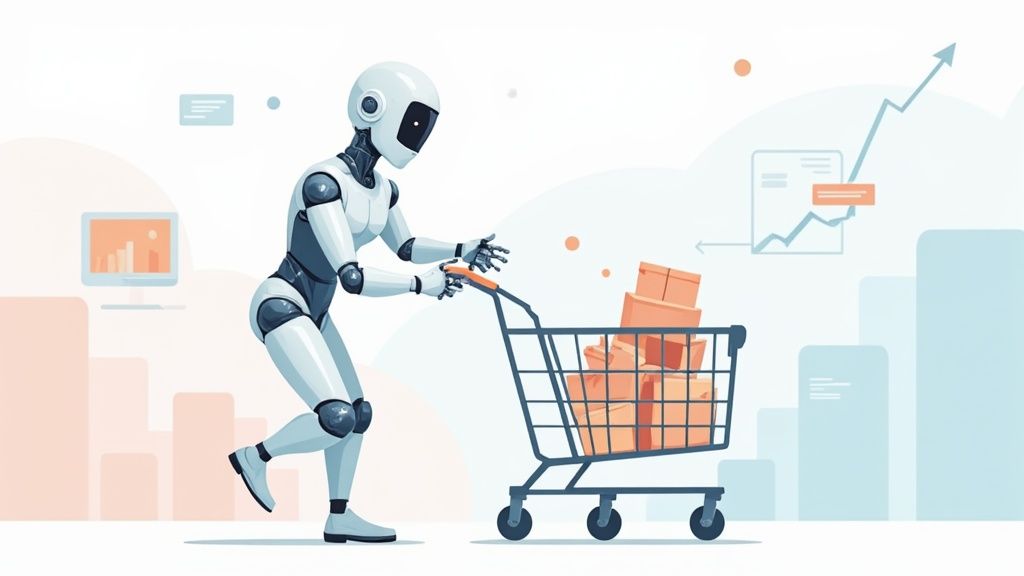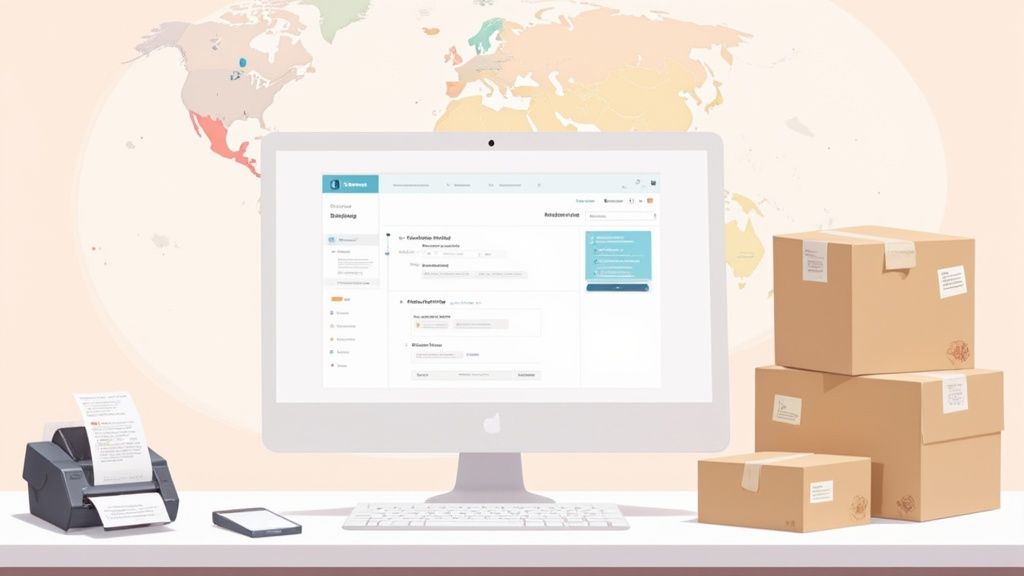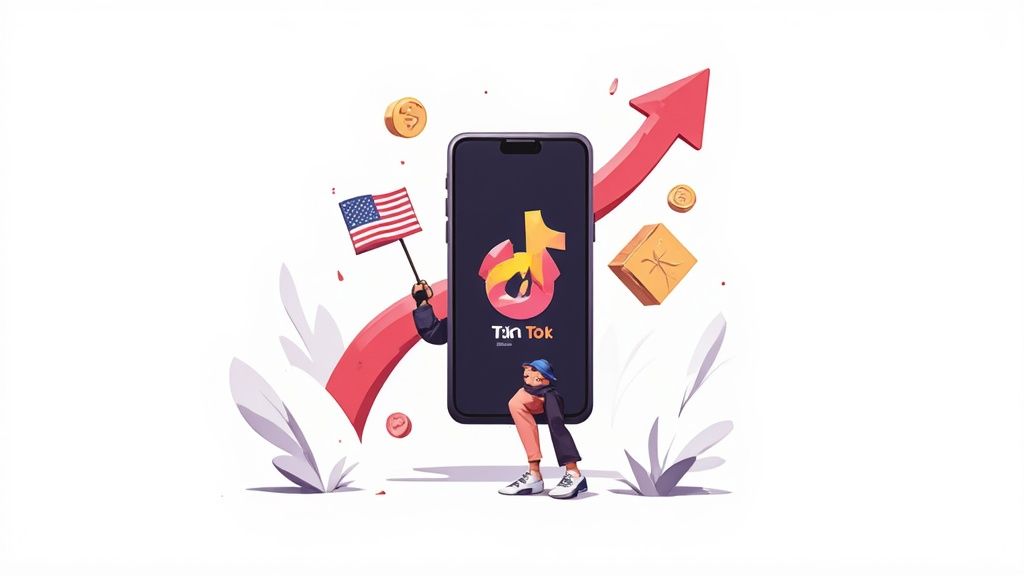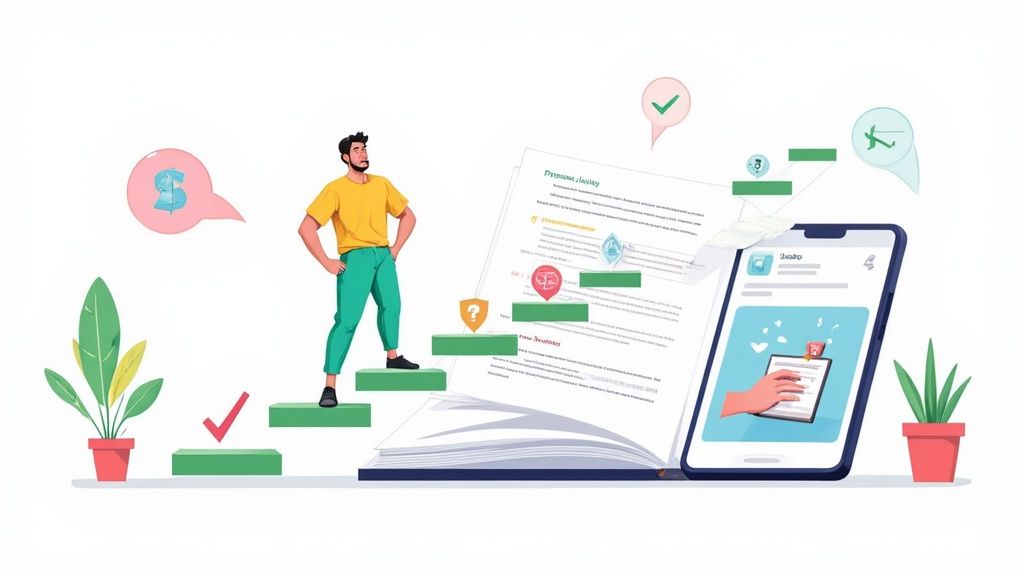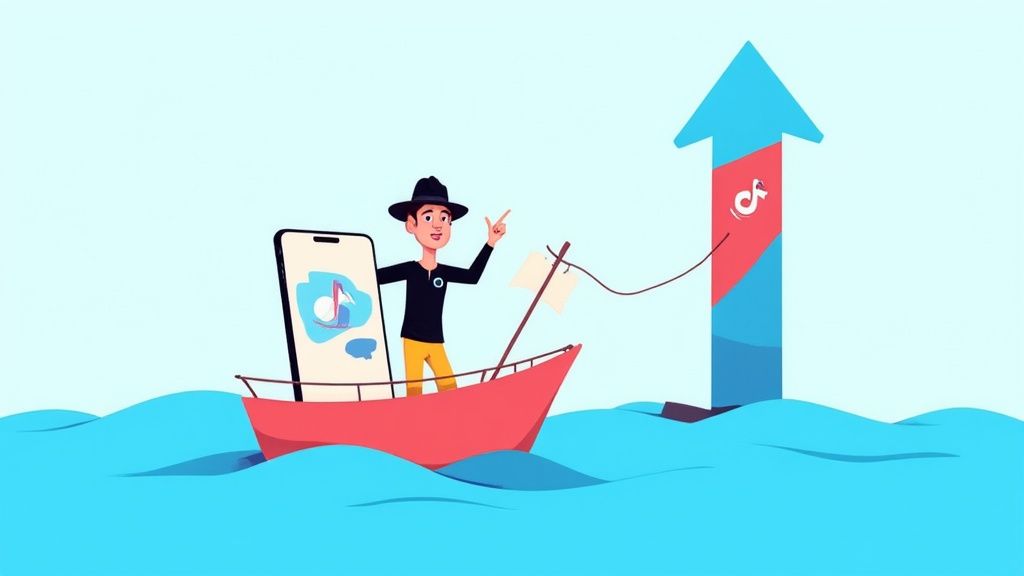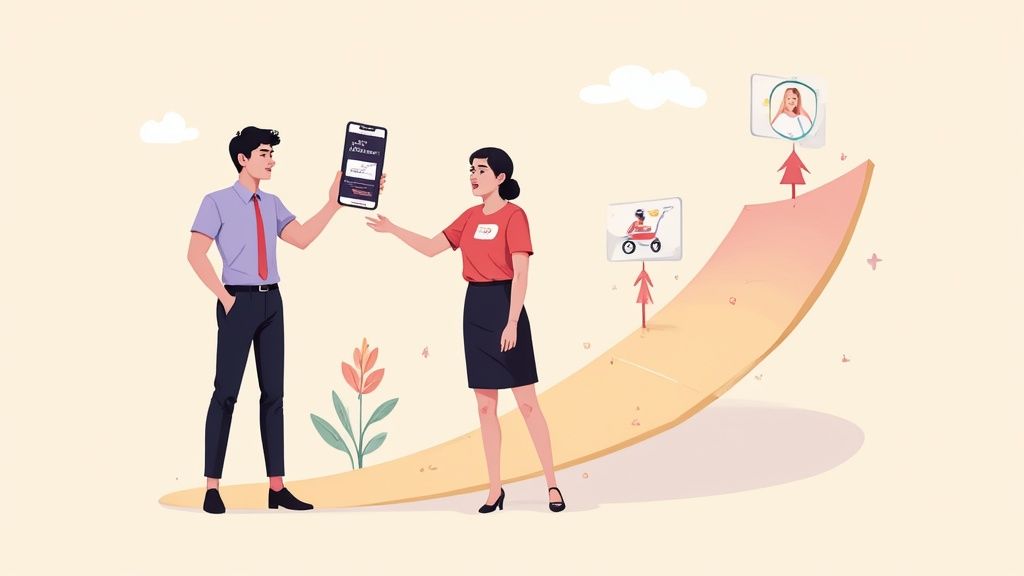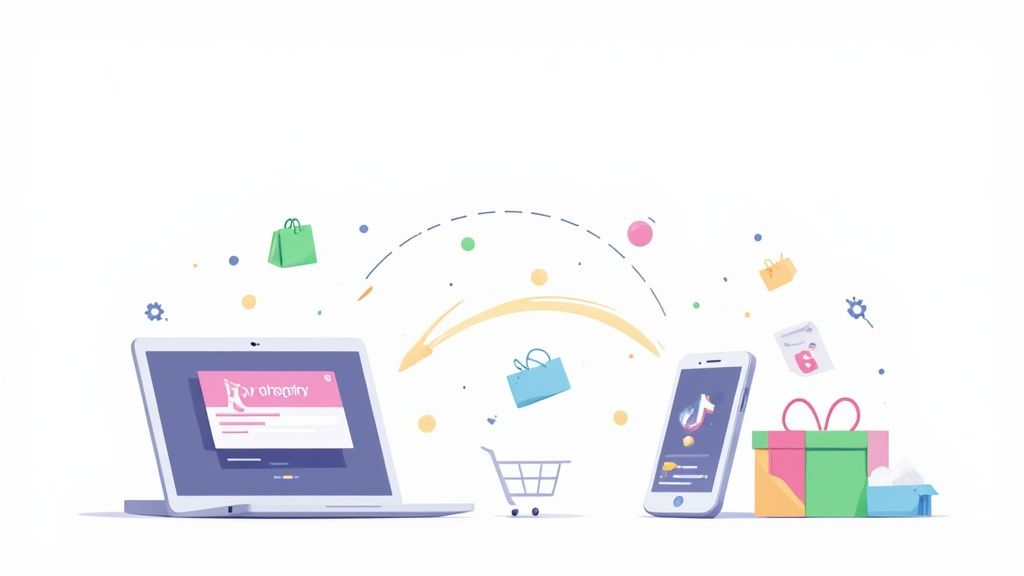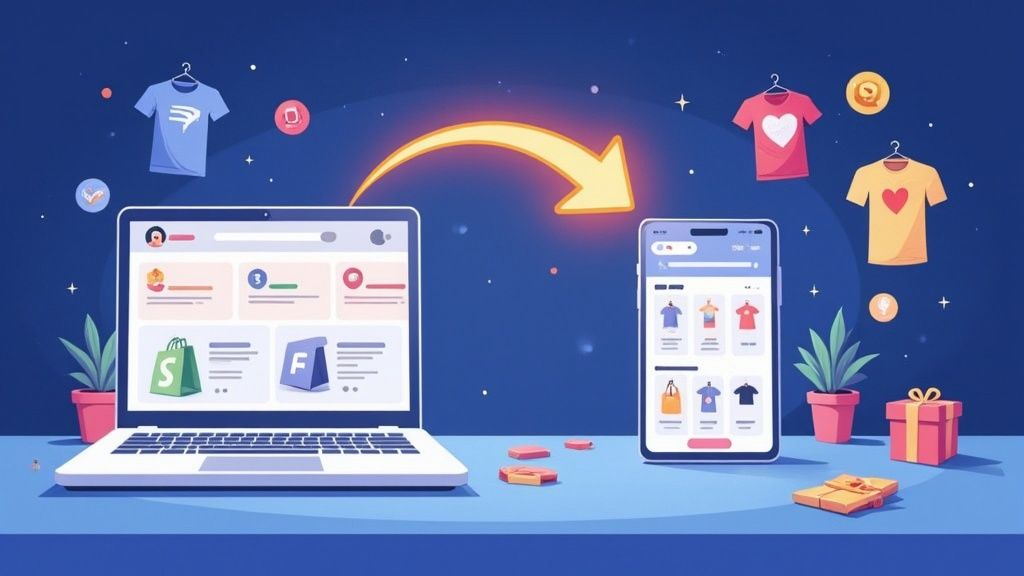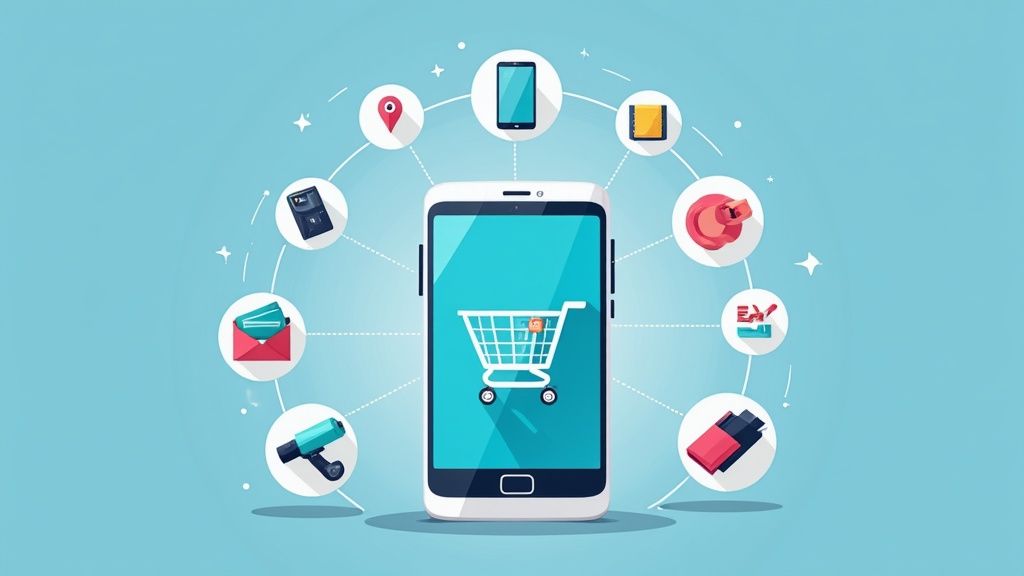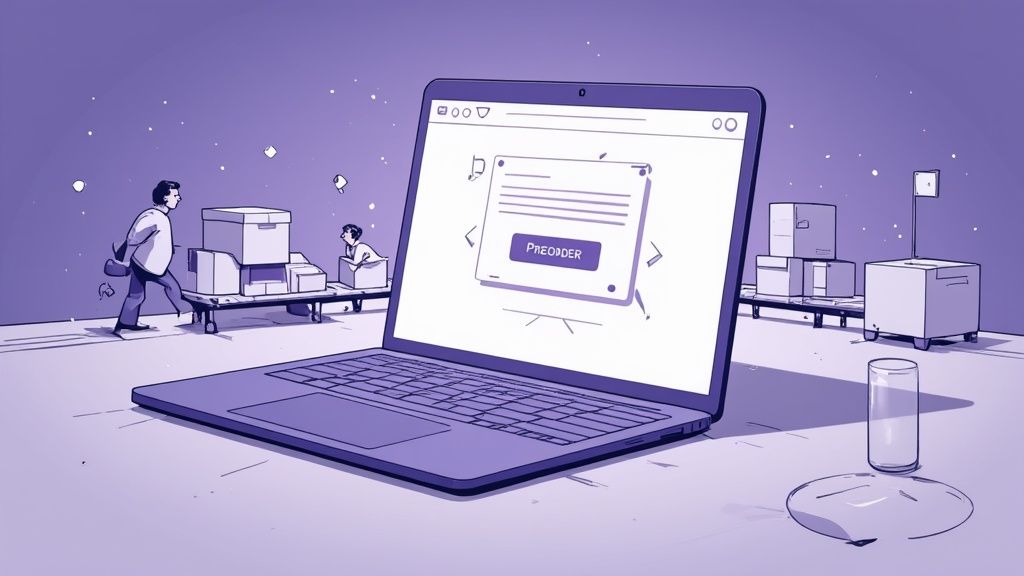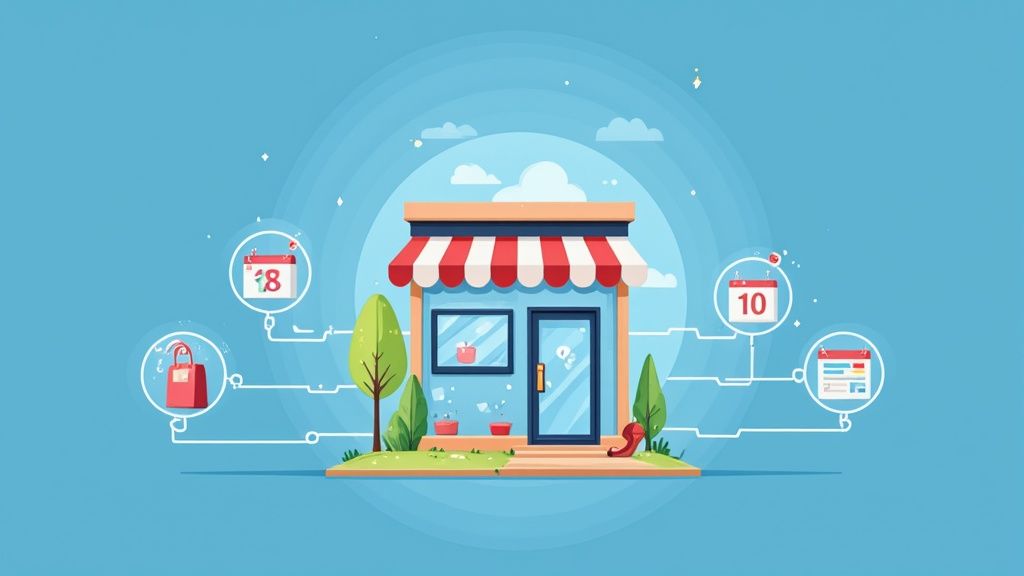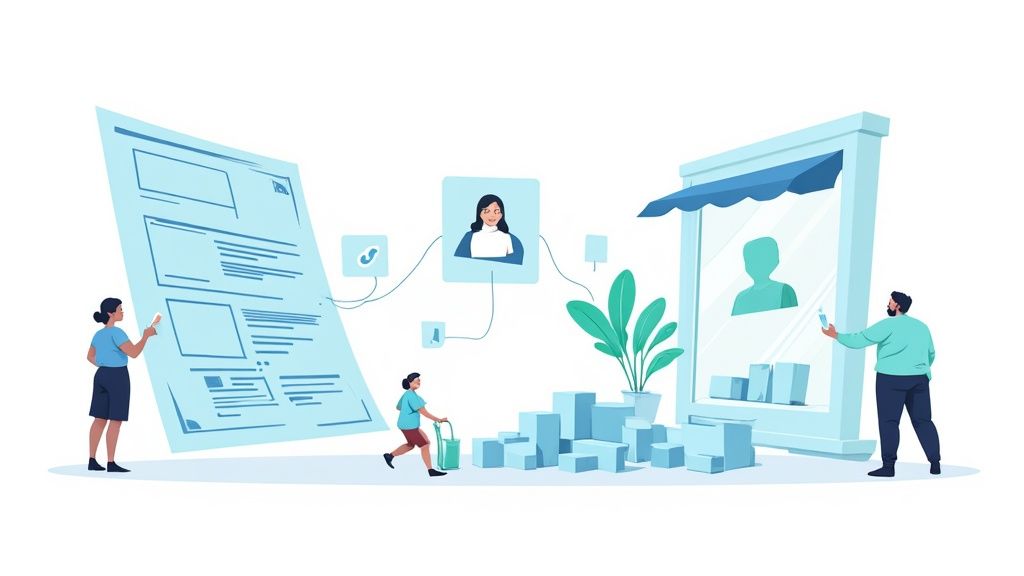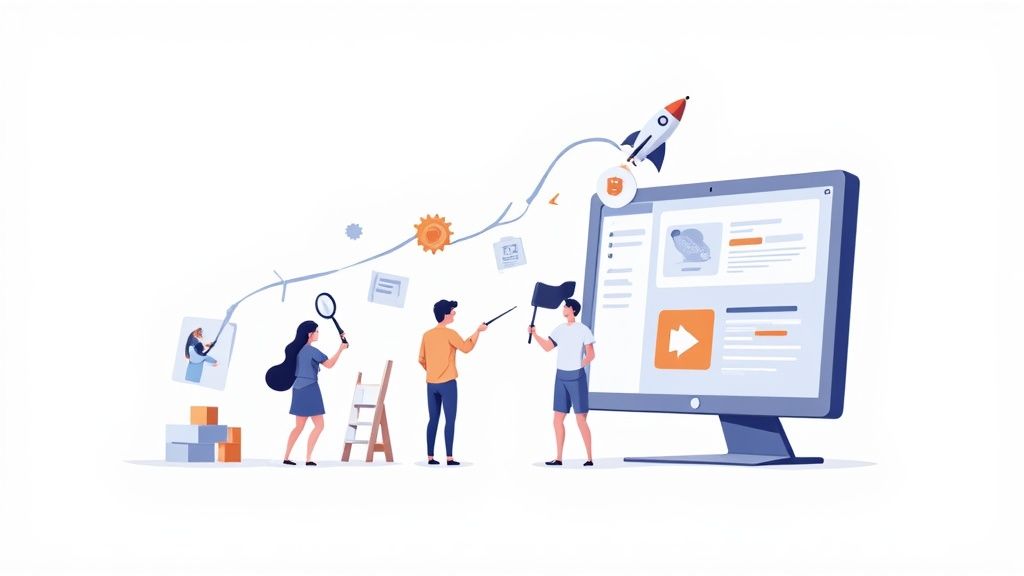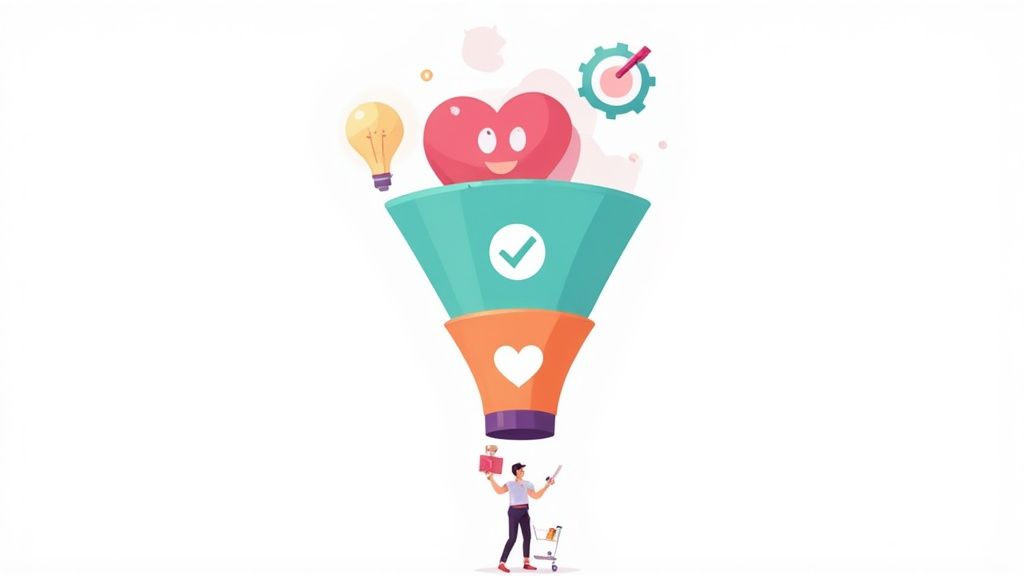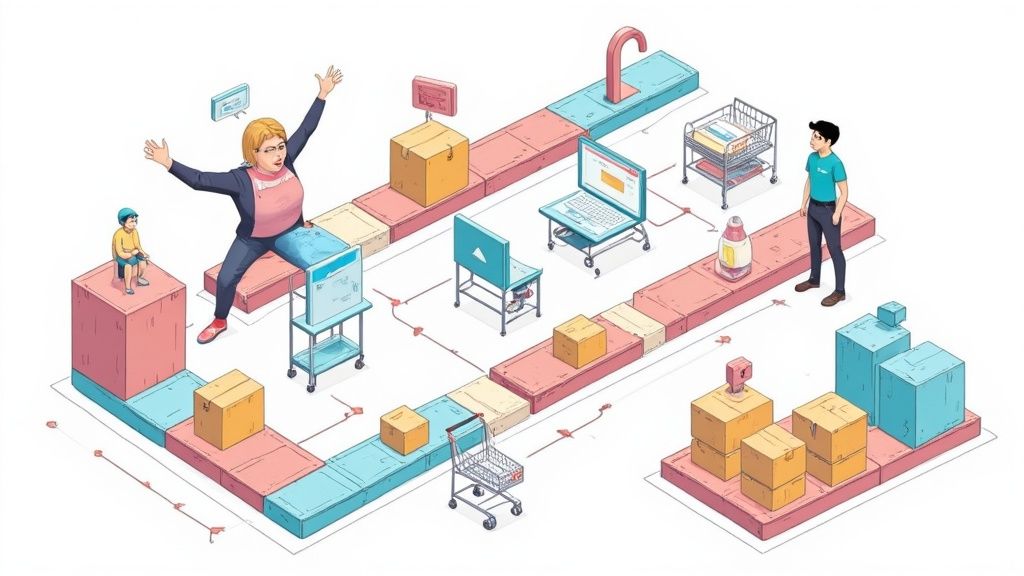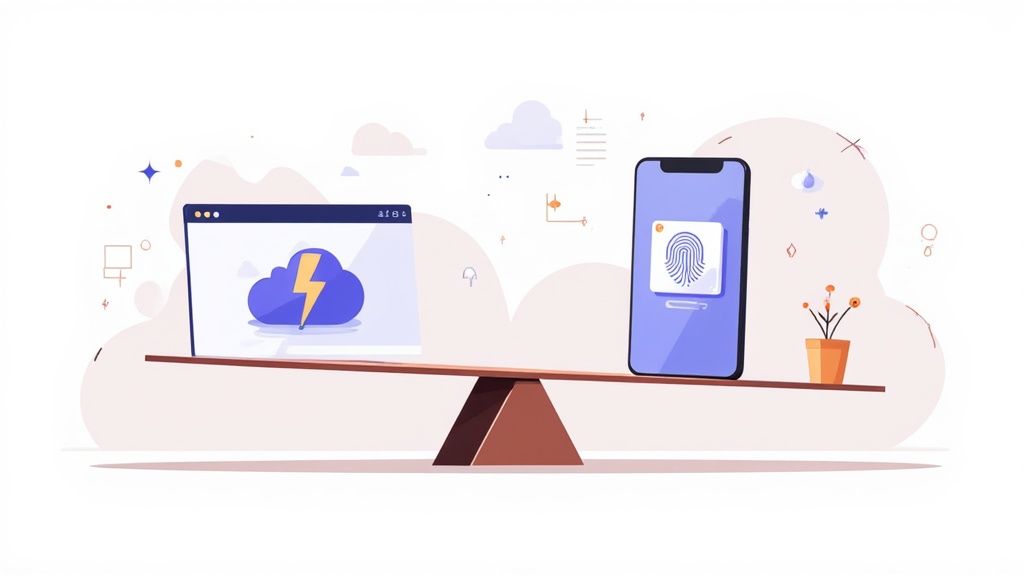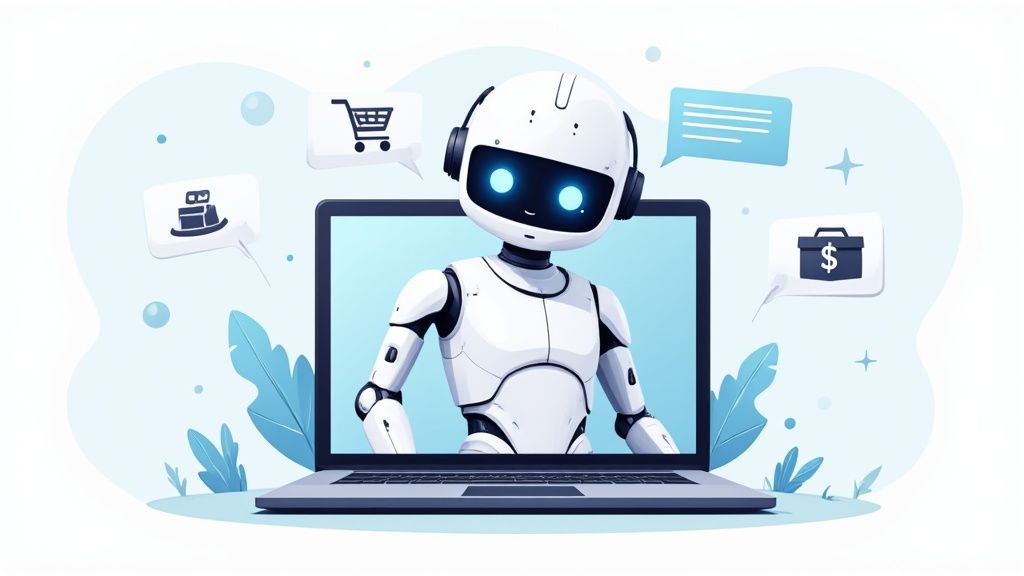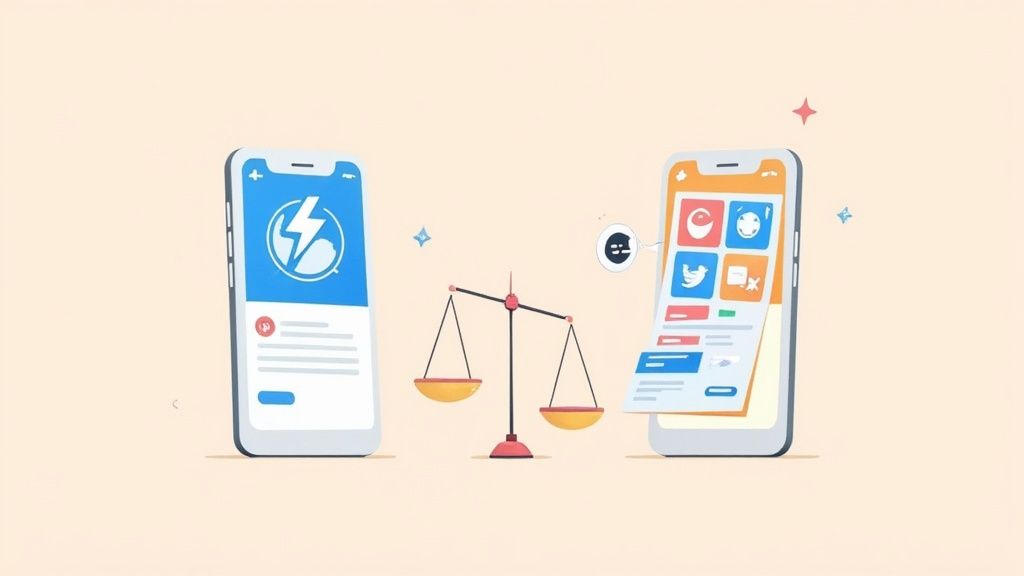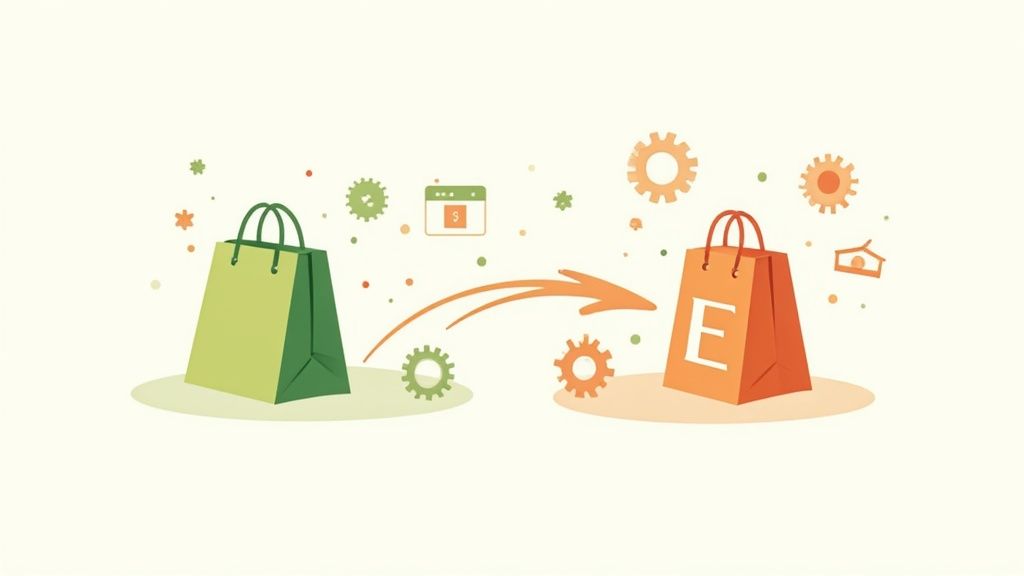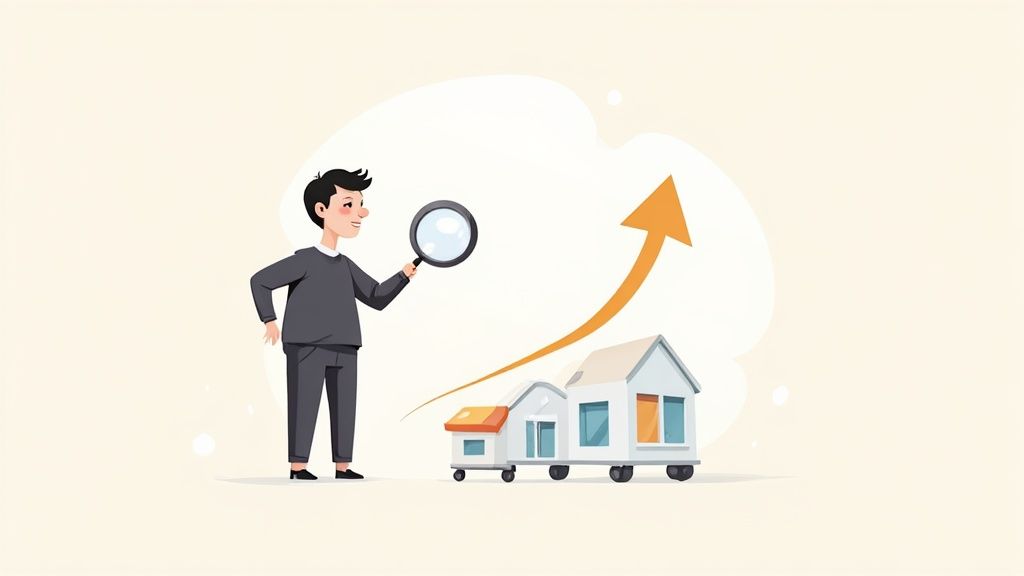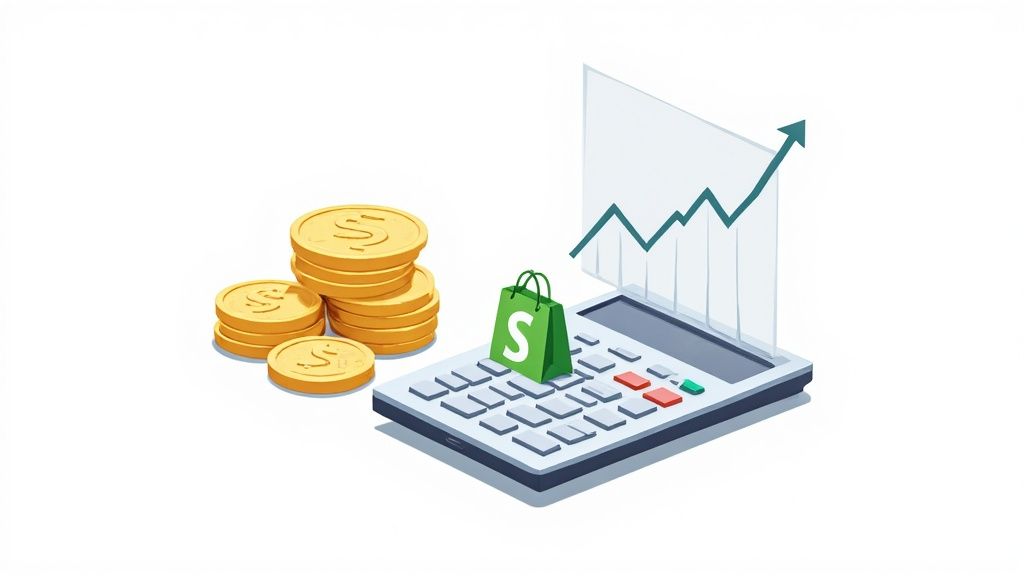
Let's cut through the buzzwords. What exactly is headless commerce?
At its core, headless commerce is an e-commerce setup where the customer-facing frontend store (the 'head') is completely separate from the backend commerce engine (the 'body'). This approach lets you build totally unique customer experiences with any frontend technology you want, while a powerful, centralized backend handles the heavy lifting like inventory, pricing, and checkouts.
Understanding Headless Commerce Without the Jargon
Think about a typical, old-school retail store. The building itself, the product displays on the shelves, the cash register, and the stockroom are all one big, interconnected system. You can’t just decide to knock down the front wall and replace it with glass without disrupting the entire operation. This is basically how traditional, or monolithic, e-commerce platforms work—the frontend (what your customers see and interact with) and the backend (all the business logic) are tightly coupled.
Headless commerce completely flips that model. Picture it more like a central warehouse (the backend) that operates entirely on its own. This warehouse is brilliant at what it does: it tracks product information, manages every piece of inventory, and processes orders flawlessly. The crucial difference? It doesn't have its own fixed storefront.
Instead, this warehouse uses a team of super-efficient messengers, known in the tech world as APIs (Application Programming Interfaces), to deliver product data and complete transactions for any storefront you can dream up.
The Power of Decoupling
This separation, or "decoupling," is the magic behind headless commerce. It means you can build a stunning, custom-designed website, a sleek mobile app, a shoppable Instagram feed, or even a futuristic experience for a smart mirror—and have them all powered by the exact same backend system.
What does this decoupling actually get you?
- Total Creative Freedom: Your designers and developers are no longer boxed in by the rigid templates of a traditional platform. They have a blank canvas to build the best possible user experience from the ground up.
- Omnichannel Readiness: You can sell your products seamlessly and consistently across any digital channel your customers are on, whether it's a laptop, a smartwatch, or a voice assistant.
- Faster Performance: Because the frontend is independent, it can be hyper-optimized for speed. In e-commerce, speed is everything—it directly impacts customer happiness and your search engine rankings.
By detaching the customer experience layer from the commerce engine, headless commerce introduces an agile, API-first model that allows for greater flexibility in designing and deploying unique digital storefronts.
To make this crystal clear, let's look at a quick side-by-side comparison.
Traditional vs. Headless Commerce At a Glance
The table below breaks down the fundamental differences between the two architectures, highlighting how they impact key areas of your business.
As you can see, the choice between traditional and headless isn't just a technical one—it has major implications for your brand's agility, creativity, and ability to meet customers wherever they are.
This simple infographic helps visualize the difference.

The visualization really drives the point home. The decoupled nature of headless architecture is what empowers brands to customize faster and deploy updates more frequently. This gives you a serious competitive edge, letting you innovate on the customer journey without being held back by backend limitations. It's a fundamental shift in how modern retail works.
How the Headless Architecture Actually Works

To really get what makes headless commerce so powerful, you have to look under the hood. It might sound super technical, but the core idea is actually pretty simple once you see how the moving parts connect. The secret ingredient holding it all together is the API (Application Programming Interface).
Picture your e-commerce backend—the system managing your product data, orders, and customer accounts—as a central kitchen. In a traditional setup, that kitchen is permanently attached to a single restaurant, which is your website's frontend. With headless, that kitchen is now a standalone operation built for delivery.
The APIs are your delivery drivers. They don't cook the food (manage the data) or build the restaurant (design the frontend). Their only job is to take specific orders (data requests) from any "restaurant" you own, zip back to the kitchen, pick up the right meal (data), and deliver it.
The Critical Role of APIs
At its heart, an API is just a set of rules that lets different pieces of software talk to each other. In a headless system, APIs are the essential bridge connecting your backend commerce engine to any customer-facing "head" you can dream up.
When a customer lands on your custom website and clicks a product, that product information isn't stored on the page itself. Instead, the frontend fires off a quick API request to the backend, basically asking, "Hey, I need the price, description, and images for product #123." The backend grabs that data and uses the API to send it right back, where the frontend displays it beautifully for the customer.
This API-driven conversation happens constantly for almost every interaction:
- Checking if an item is in stock
- Adding a product to the cart
- Applying a discount code
- Submitting a customer review
By using APIs as the go-between, your frontend and backend can evolve independently. Your developers can completely overhaul the website or launch a brand new mobile app without ever touching the core backend system. This separation is the real key to agility.
To get a better sense of the bigger picture involved in building these kinds of sophisticated e-commerce solutions, it's helpful to understand the 7 stages of website development. This process covers the planning, design, and coding needed to bring a complex frontend to life.
Visualizing the Data Flow
Let's walk through a real-world scenario to see how data moves in a headless architecture.
- The Backend "Body": This is your central command center for commerce. It could be a platform like Shopify or BigCommerce, or even a custom solution. It holds all your vital data: products, pricing, inventory levels, customer profiles, and order history.
- The API Layer: This is the communication highway. Your backend exposes its data through different APIs, like a "Product API," a "Cart API," and an "Order API."
- Your Main Website: Built with a modern JavaScript framework for a blazing-fast, app-like experience.
- A Mobile App: Developed natively for iOS and Android to create a perfectly tailored mobile journey.
- An In-Store Kiosk: A tablet in your physical shop that lets customers browse your entire online catalog.
- Improved User Experience: A fast, responsive site keeps customers happy and engaged, which means lower bounce rates.
- Better SEO Rankings: Search engines like Google actively reward speedy websites with higher rankings, boosting your organic traffic.
- Higher Conversion Rates: A quick, frictionless experience removes the annoying barriers that stop people from buying.
- Websites and mobile apps
- Social media storefronts
- Voice assistants and smart speakers
- In-store kiosks and digital displays
- Internet of Things (IoT) devices like smart fridges
- Lightning-Fast Speed: They built a custom frontend totally optimized for performance. The result? Pages that load almost instantly. This is absolutely critical for keeping shoppers from bouncing during a massive sneaker release.
- Rich, Immersive Storytelling: Going headless let them weave in dynamic content, stunning high-res videos, and interactive product stories without dragging down the site's speed. The shopping experience became part of the brand story.
- Personalized Mobile Experience: The SNKRS app is a masterclass in headless. It offers a super-personalized, content-first journey that feels completely unique, yet it's all powered by the same backend commerce engine. This keeps inventory and user profiles perfectly synced across every touchpoint.
Storefront API: This is the heart and soul of Shopify's headless offering. The Storefront API is your direct line to all your store's data. It lets you securely pull product info, create carts, and manage customer accounts from any frontend you can dream up. It’s built for speed and flexibility, giving developers the raw data they need without getting in the way.
Hydrogen: Think of Hydrogen as a starter kit for building custom storefronts on Shopify. It’s a framework based on React that comes packed with pre-built components, hooks, and utilities already wired up to the Storefront API. This is a massive time-saver, as your developers aren't starting from scratch.
Oxygen: So you’ve built your beautiful custom storefront with Hydrogen. Where do you host it? That's where Oxygen comes in. It's Shopify's own hosting solution, engineered for fast, global delivery and designed to work perfectly with Hydrogen builds. It’s a serverless environment that ensures your custom site is just as fast and dependable as a standard Shopify theme.
- Brand experience is your secret weapon. If you need a unique user journey that cookie-cutter templates just can't deliver, headless gives you that creative freedom.
- You're planning to grow beyond just a website. Got big dreams for a mobile app, in-store kiosks, or other digital touchpoints? Starting with a headless foundation makes that expansion so much easier down the line.
- Your site speed is killing your sales. If your current site is slow and you know you're losing conversions because of it, a lightning-fast, custom headless frontend can deliver a serious return.
- Needing Specialized Skills: You'll need developers who are comfortable with modern frontend frameworks (like React, Vue, or Svelte) and know their way around API integrations.
- Higher Upfront Cost and Time: Building a custom storefront from the ground up simply takes more time and resources than picking a pre-built theme and tweaking it.
- Ongoing Maintenance: You're on the hook for hosting, maintaining, and updating the frontend. That means you need a dedicated technical person or team ready to handle it.
When a customer adds an item to their cart on the mobile app, the app’s frontend sends a request through the Cart API. The backend processes it, updating the cart's status. If that same customer later logs into their account on the main website, the website's frontend will make its own API call to fetch the same, updated cart information. The result is a seamless and unified experience, no matter the device.
This flexible architecture is quickly becoming the new normal for a reason. The global headless commerce market is set to explode, growing from $1.74 billion in 2025 to a projected $7.16 billion by 2032. This growth is fueled by brands needing exactly this kind of agile, personalized customer interaction to stay competitive.
The Business Benefits of Going Headless
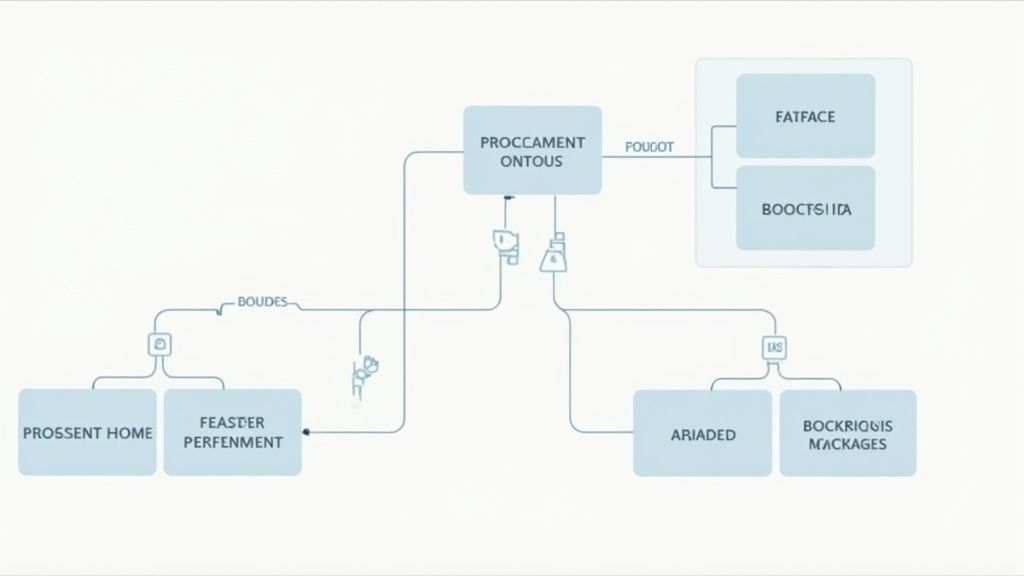 Understanding the architecture is one thing, but the real question is simple: what can headless commerce actually do for your bottom line? Switching from a traditional setup to a headless model isn't just a tech upgrade; it's a strategic move that unlocks some very real advantages. These benefits go way beyond the code, directly impacting everything from your customer experience to your ability to innovate and stay ahead.
Understanding the architecture is one thing, but the real question is simple: what can headless commerce actually do for your bottom line? Switching from a traditional setup to a headless model isn't just a tech upgrade; it's a strategic move that unlocks some very real advantages. These benefits go way beyond the code, directly impacting everything from your customer experience to your ability to innovate and stay ahead.
By decoupling your frontend "head" from the backend "body," you suddenly gain a level of control and flexibility that old-school monolithic platforms just can't match. This translates directly into measurable wins like faster site performance, better conversion rates, and the agility to pounce on new market opportunities. Let’s break down the biggest business outcomes you can expect.
Unmatched Creative Freedom and Brand Expression
With traditional platforms, your creativity is often boxed in by pre-built templates. Sure, you can swap out colors and fonts, but genuine customization is often a frustrating and expensive ordeal. This can easily lead to a generic, cookie-cutter storefront that does a poor job of showing off what makes your brand unique.
Headless commerce completely shatters those limits. Your designers and developers are given total freedom to build any customer experience they can dream up, using the best modern tools for the job. You can create immersive product pages, interactive 3D models, or a completely custom checkout flow that feels like a natural extension of your brand.
This is the kind of control that ensures your brand's story is told powerfully and consistently at every single touchpoint, creating a memorable experience that builds real customer loyalty.
"Businesses that adopted headless commerce saw a 50% reduction in the time it took to launch new digital experiences. This increased speed-to-market allows brands to quickly adapt to consumer demands and stay ahead of competitors."
Superior Performance and Conversion Rate Optimization
In ecommerce, speed is everything. A delay of even one second in page load time can send your conversion rates plummeting. Traditional platforms, with their heavy, all-in-one codebases, often struggle with performance, especially on mobile.
Headless architecture, on the other hand, allows for a hyper-optimized frontend. Because it’s a totally separate application, it can be built with lightweight frameworks designed for one thing: delivering lightning-fast load times. This leads to some major wins:
This focus on performance isn't just a "nice-to-have"—it's a core driver of revenue. Investing in the right ecommerce development services is key to making sure your headless build is optimized for maximum speed from day one.
True Omnichannel Readiness for Modern Retail
Today's customer journey is all over the place. A shopper might see a product on Instagram, read about it on a blog, add it to their cart on a mobile app, and finally check out on their laptop. A headless architecture isn't just ready for this reality—it was built for it.
Since a single backend can power an endless number of frontends, you can deliver a consistent and seamless brand experience no matter where your customers are. This API-first approach ensures that your inventory, pricing, and customer data are always in sync across every channel. You can meet your customers on:
This kind of omnichannel presence is no longer optional; it's essential for meeting modern customer expectations and building a business that's ready for whatever comes next. The market is already moving in this direction. Around 80% of companies not currently using headless plan to make the switch within two years, with current users reporting benefits like a 25% increase in conversion rates. You can find more insights in these headless commerce statistics on Webyking.com.
Inspiring Headless Commerce Examples in Action
Theory is a great starting point, but nothing beats seeing how top-tier brands use headless commerce in the real world to truly grasp its power. These companies weren't just chasing the latest tech trend; they were up against real business hurdles—sluggish performance, a lack of creative freedom, you name it. A headless architecture was their solution.
By digging into their stories, we can see exactly how separating the frontend from the backend gives them a serious competitive edge. It's not just about flashy websites. It's about solving real problems and building customer experiences that fuel growth. Let's see how a couple of the biggest names in retail made it happen.
Nike's Pursuit of Ultimate Performance
Nike is a brand that lives and breathes performance and speed. It's no surprise they demand the same from their digital storefront. Their mission was to create a slick, app-like experience across their website and mobile platforms—one that could handle the insane traffic of their product drops and global campaigns. Their old, traditional system was just too slow and clunky to live up to the high-octane brand they've built.
Switching to a headless model helped Nike nail a few key goals:
Nike's headless setup gives them the agility to dream up and launch unique digital campaigns on the fly, cementing their reputation as an innovator in both sportswear and e-commerce.
Target's Omnichannel Dominance
Target has mastered the art of being a one-stop shop, brilliantly blending its massive network of physical stores with a powerhouse digital presence. Their big challenge was creating one unified experience, allowing a customer to move effortlessly from the website to their award-winning app to an in-store visit. A traditional commerce setup made this a nightmare, leading to siloed systems and a clunky, disjointed experience for shoppers.
Headless architecture was the key to unlocking Target's vision for a true omnichannel ecosystem. It allowed them to create a consistent and connected shopping experience, no matter how a customer chose to interact with the brand.
By going headless, Target managed to plug all its channels into one central commerce brain. This means a customer can browse online, add an item to their cart from the mobile app while in the store, and then use in-store pickup, all within one seamless system. It's this frictionless experience that has supercharged the adoption of services like Drive Up and Order Pickup, making them a core part of Target's success.
Critically, their headless setup ensures that the inventory you see online is an accurate, real-time reflection of what’s actually on the shelf in your local store—an absolute must-have for a modern retail giant.
Using Headless Commerce with Shopify
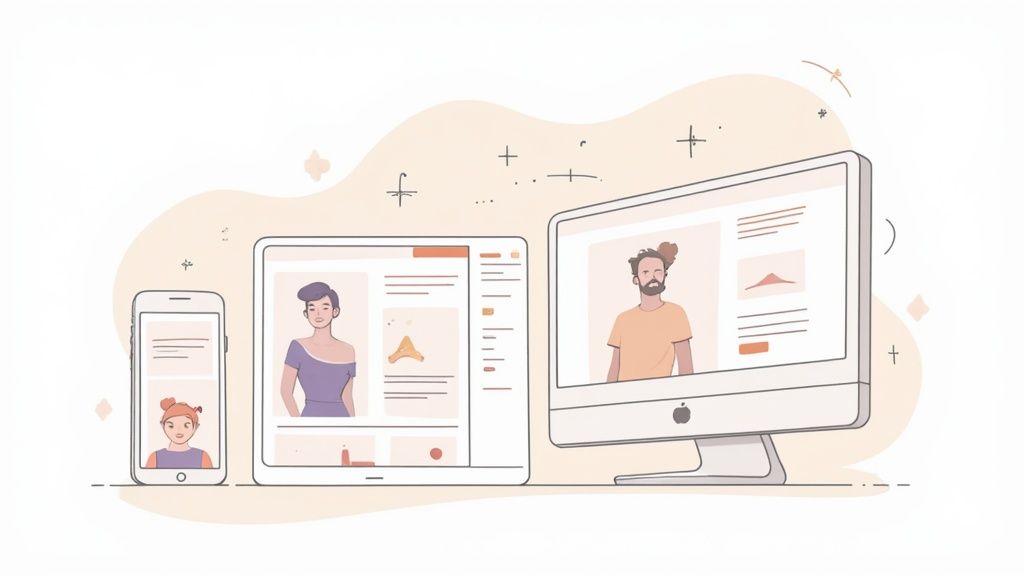
For the millions of merchants who trust Shopify to run their business, the idea of "going headless" can sound intimidating and maybe even a little out of reach. But the truth is, Shopify has leaned heavily into the API-first world, building a powerful suite of tools that makes a headless approach surprisingly accessible.
This setup answers a huge question for ambitious brands: how do you create a truly unique, lightning-fast shopping experience without giving up the stability and features of a top-tier commerce platform? Shopify’s answer is to let you decouple the frontend. You get to keep the best parts of Shopify—its world-class checkout, reliable backend, and order management—while gaining total creative control over the customer-facing experience.
Shopify's Headless Technology Stack
Shopify doesn't just allow a headless setup; it actively supports it with specialized tools built to make life easier for developers. These pieces work together to help you build and launch a custom storefront that’s powered by Shopify’s rock-solid commerce engine.
This combination of tools provides a clear path for merchants wanting to graduate from a standard theme to a fully custom, high-performance experience. As you map out your strategy, it's smart to compare various e-commerce platforms like Shopify, WooCommerce, and BigCommerce to see how their headless capabilities stack up.
A headless Shopify build isn't about replacing Shopify. It's about enhancing it, pairing its robust backend with a frontend that is built without compromise for your specific brand vision and performance goals.
The Real-World Benefits for Shopify Merchants
So, why go through all the effort of a custom build? For many growing brands, the benefits directly solve the pain points they hit with traditional themes. The biggest win is the ability to create a completely bespoke user experience that can send performance and conversions through the roof.
This strategy is especially powerful right now. The global e-commerce market, with its 28 million online stores, is fiercely competitive. With projections showing online retail revenue soaring past $6.8 trillion by 2025, a unique and blazing-fast storefront isn’t a luxury anymore—it’s how you capture attention and win sales.
For Shopify users, going headless unlocks the power to truly stand out. You can build a site that not only looks exactly how you want but also delivers an unforgettable user journey. If you’re a Shopify merchant thinking about taking this next step, our in-depth https://www.ecorn.agency/blog/shopify-headless-commerce-guide provides a detailed roadmap to help you get started.
Common Questions About Headless Commerce
By now, some practical questions are probably swirling in your head. It’s one thing to get the concept of headless commerce, but it's another thing entirely to figure out if it actually makes sense for your business. Making a smart decision means tackling the real-world concerns head-on.
Let's cut right to the chase and get those critical questions answered. We'll dig into whether this approach is realistic for smaller stores, what bumps to expect on the road to implementation, and how it all plays out for your SEO.
Is Headless Commerce a Good Fit for Small Businesses?
This is a big one, and the answer has changed a lot recently. Headless used to be seen as a playground for huge enterprise brands with massive dev teams, but that’s not really the case anymore. The real key is weighing the costs against the benefits for your specific situation.
For a small business, going headless is a solid bet if:
But you have to be realistic. The initial investment in development and the need for more specialized technical skills are definitely higher than with a standard, all-in-one platform.
For many small businesses, it really comes down to ambition. If your goal is to build a powerful, unique brand experience that can grow with you, the upfront investment in a headless setup can pay off in a huge way over the long haul.
What Are the Biggest Implementation Challenges?
Moving to a headless architecture is a major project, and it comes with its own unique set of challenges. The main hurdle is the jump in technical complexity. Unlike an all-in-one platform where everything is bundled, you're now in charge of building and maintaining the frontend and making sure it talks to the backend through APIs.
This creates a few specific hurdles:
How Does Headless Commerce Affect SEO?
When done right, headless commerce can be a massive win for your SEO. The single biggest advantage is site speed. Because the frontend is completely separate, it can be fine-tuned for incredibly fast load times—a huge ranking factor for Google. A better, faster experience also leads to lower bounce rates and more engaged users, which sends all the right signals to search engines.
There's a technical catch, though. Since the content is often rendered by the user's browser with JavaScript, you have to make sure search engine bots can properly crawl and index your pages. This means that implementing server-side rendering (SSR) or static site generation (SSG) is non-negotiable for strong SEO.
Without that technical SEO foundation, you could build an amazing site that's basically invisible to Google.
Ready to build an e-commerce experience that truly stands out? The team at ECORN specializes in high-performance Shopify development and strategic CRO. Whether you need a custom headless storefront or want to optimize your current setup, we have the expertise to help you scale. Learn more and see what we can build together.






